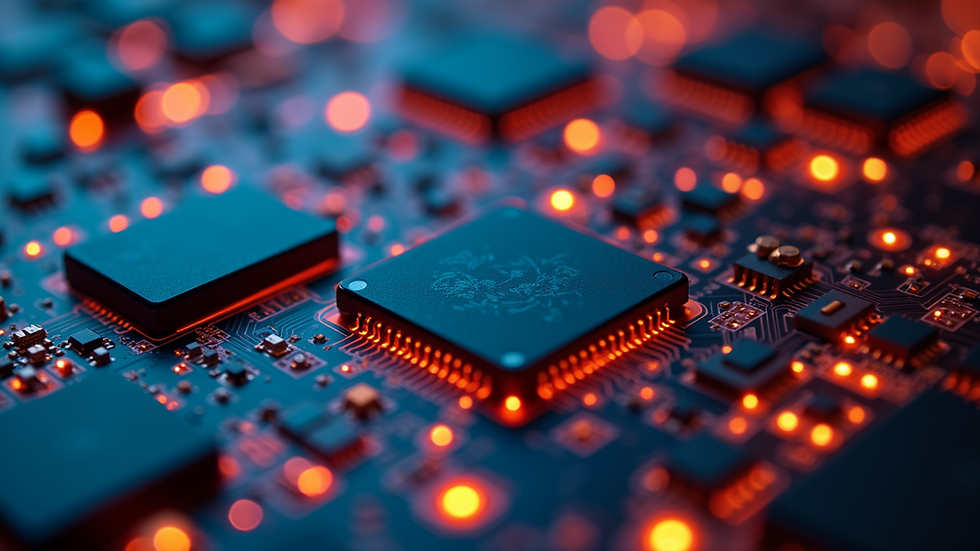Exploring the Intricacies of AI and ML in a Changing Technological Landscape
- David otu
- Mar 21
- 3 min read
Updated: May 9
Artificial intelligence (AI) and machine learning (ML) are no longer just futuristic concepts. They are now integral parts of our daily lives. From voice assistants in our smartphones to algorithms that recommend the next movie to watch, AI and ML are everywhere. These technologies analyze vast amounts of data to refine our experiences and make predictions that can affect everything from healthcare outcomes to financial security. Understanding AI and ML is essential as we navigate this dynamic technological landscape full of potential and challenges.
AI refers to systems that can perform tasks that typically require human intelligence. Machine learning, a subset of AI, allows these systems to learn from data and improve over time without specific programming for every new situation. Together, these technologies are transforming industries and empowering innovations.
The Evolution of AI and ML
The journey of AI and ML began in the 1950s. Early ideas focused on creating machines that could think like humans, but initial attempts were limited by technology. A significant breakthrough came in the 1980s with the development of backpropagation, a technique that made training neural networks much more efficient.
However, the real transformation happened in the 21st century with the advent of big data and powerful computing resources. For instance, in 2012, deep learning algorithms demonstrated an ability to accurately classify images with over 80% accuracy, marking a turning point for AI applications. Today, companies across industries are leveraging AI and ML; for example, IBM reports that AI can enhance business productivity by up to 40%.
Applications in Various Industries
AI and ML have diverse applications, showcasing their transformative potential across different sectors.
Healthcare
AI is at the forefront of revolutionizing healthcare. Machine learning algorithms can analyze medical images, such as X-rays and MRIs, to identify conditions like tumors with a success rate of around 85%. For example, a study showed that AI could detect breast cancer up to 15% more accurately than human radiologists. Early detection can lead to timely interventions, potentially saving thousands of lives each year.
Finance
In finance, AI and ML are crucial in identifying fraud and assessing risks. Financial institutions employ algorithms that can analyze millions of transactions to recognize patterns and flag unusual activities in real-time. According to a report from the Association of Certified Fraud Examiners, organizations implementing AI-powered solutions saw a 30% decrease in fraud cases.
Retail
Retailers are enhancing customer experiences through AI. By analyzing purchase histories and online behavior, machine learning systems can provide personalized product recommendations, leading to a 20% increase in sales for many e-commerce platforms. Additionally, AI-powered chatbots improve customer service by resolving queries 24/7, improving both satisfaction and efficiency.
While these examples highlight the ways AI and ML revolutionize industries, the underlying technology involves complex algorithms and ongoing data improvements.
Ethical Considerations
The rapid growth of AI and ML also prompts important ethical questions. As these systems learn from data, biases can emerge. According to the MIT Media Lab, AI systems can exhibit biases that affect marginalized communities unfairly. Transparency in AI decision-making processes is necessary to build trust and mitigate these issues.
Moreover, the rise of autonomous systems raises concerns about job displacement. A World Economic Forum report estimates that 85 million jobs may be displaced by 2025 due to AI, while 97 million new roles could emerge. Striking a balance between innovation and ensuring ethical standards must be a priority for organizations.
To address these concerns, companies should implement guidelines that promote ethical AI development, focusing on transparency, fairness, and accountability.
The Future of AI and ML
The future of AI and ML is both exciting and full of uncertainties. As we develop more refined algorithms, we anticipate systems that can handle increasingly complex tasks. For example, advancements in quantum computing could greatly enhance AI capabilities, allowing for faster data processing and better decision-making.
AI will infiltrate more areas of our lives, shaping how we learn, travel, and interact. For instance, self-driving cars are already being tested in various cities, and intelligent educational tools are gaining traction in classrooms. Collaboration between humans and intelligent systems will become vital. While AI excels in data processing, human traits like creativity and emotional intelligence will still play crucial roles in many fields.
The Road Ahead
As we explore the intricacies of AI and ML, we recognize that these technologies are reshaping our world in profound ways. Their applications extend across multiple industries, driving efficiency and generating innovation. However, it is essential to also focus on the ethical implications that arise, as we look to maximize the benefits while minimizing harm.
Staying informed about AI and ML allows individuals and organizations to navigate challenges and seize new opportunities. The journey is ongoing, and as participants in this evolving narrative, we must prepare for the transformations that lie ahead.



Comments